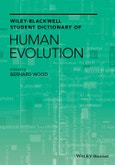Not so long ago, all a student studying human evolution needed was a familiarity with the relatively sparse fossil record and what limited information there was about the context of the sites, a basic knowledge of gross anatomy and archeology, and an understanding of simple analytical methods.
Times have changed. The fossil record has grown exponentially, imaging techniques have advanced dramatically, quantitative methods have burgeoned, and molecular biology has revolutionized our understanding of genetics, evolutionary history, and development. Added to this are advances in the archeological, biological, and earth sciences that help interpret the context of the fossil evidence and reconstruct behavior. But presently there is nowhere students of human evolution cna easily find out about topics as disparate as ameloblast, Coopers Cave, daily secretion rate, the effect hypothesis, homeobox genes, insolation, phylogenetically independent contrasts, quantitative trait locus, semicircular canals, and tephrostratigraphy.
The Wiley Blackwell Student Dictionary of Human Evolution contains upwards of 2500 entries, all drafted with an eye on the student user. It is an indispensable source for those studying human evolution.
Table of Contents
The scope covered by the entries will be the same as the scope of the Wiley–Blackwell Encyclopedia of Human Evolution:
- Methods used to investigate the relationships among the living great apes
- The fossil evidence for human evolution
- The archeological record
- What makes the behavior of modern humans distinctive and the evolutionary history of that distinctiveness
- General evolutionary principles and up–to–date information about the molecular and developmental biological approaches used in evolutionary biology
- Information about the methods used to interpret the hominin fossil and archeological records
- Information about extinct creatures found with hominin fossil evidence
- Information about past climates and habitats
- Entries for the most important fossil and/or archeological sites
- Entries for the more complete and most important hominin fossils,
- Specialist terms used to describe the hominin fossil and archeological records
- Hypotheses about human evolutionary history
- Biographies of individuals who have made significant contributions to interpreting human evolutionary history, etc.
- Where possible entries will include examples
- Entries will explain complex issues in plain and simple language
- Entries will correspond to commonly set exam questions








